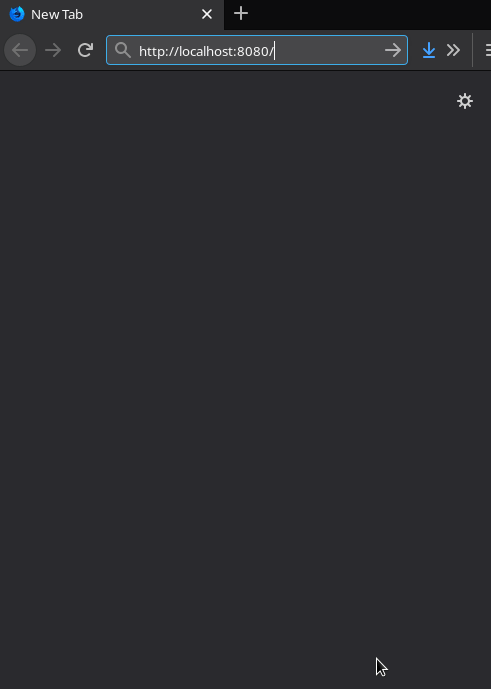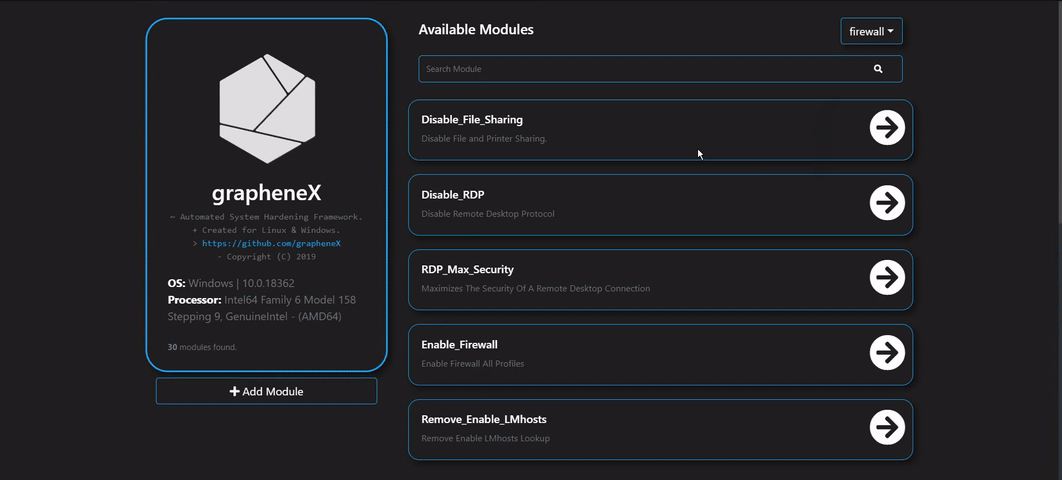Ecosyste.ms: Awesome
An open API service indexing awesome lists of open source software.
https://github.com/graphenex/graphenex
Automated System Hardening Framework
https://github.com/graphenex/graphenex
hacktoberfest hardening hardening-commands security
Last synced: about 2 months ago
JSON representation
Automated System Hardening Framework
- Host: GitHub
- URL: https://github.com/graphenex/graphenex
- Owner: grapheneX
- License: gpl-3.0
- Created: 2019-03-25T20:22:26.000Z (almost 6 years ago)
- Default Branch: master
- Last Pushed: 2024-06-25T20:56:25.000Z (6 months ago)
- Last Synced: 2024-10-04T10:37:03.983Z (3 months ago)
- Topics: hacktoberfest, hardening, hardening-commands, security
- Language: Python
- Homepage:
- Size: 2.17 MB
- Stars: 943
- Watchers: 27
- Forks: 84
- Open Issues: 3
-
Metadata Files:
- Readme: README.md
- Contributing: CONTRIBUTING.md
- License: LICENSE
- Code of conduct: CODE_OF_CONDUCT.md
Awesome Lists containing this project
README

# grapheneX [](https://github.com/grapheneX/grapheneX/releases) [](./LICENSE) [](https://github.com/astral-sh/ruff)
> In computing, hardening is usually the process of securing a system by reducing its surface of vulnerability, which is larger when a system performs more functions; in principle a single-function system is more secure than a multipurpose one. Reducing available ways of attack typically includes changing default passwords, the removal of unnecessary software, unnecessary usernames or logins, and the disabling or removal of unnecessary services.
`grapheneX` project aims to provide a framework for securing the system with hardening commands automatically.
It's designed for the end user as well as the Linux and Windows developers due to the interface options. (interactive shell/web interface)
In addition to that, `grapheneX` can be used to secure a web server/application.
> The project name is derived from 'graphene'. Graphene is a one-atom-thick layer of carbon atoms arranged in a hexagonal lattice. In proportion to its thickness, it is about 100 times stronger than the strongest steel.
Hardening commands and the scopes of those commands are referred to `modules` and the `namespaces` in the project.
They exist at the `modules.json` file after installation. (`$PYPATH/site-packages/graphenex/modules.json`)
Additionally, it's possible to add, edit or remove modules and namespaces.
Also, the hardening operation can be automated with the presets that contain a list of modules.
Currently, grapheneX supports the hardening sections below. Each of these namespaces contains more than one module.
• Firewall
• User
• Network
• Services
• Kernel
• Filesystem
• Other
Listen to The Python Podcast.\_\_init\_\_: [Automate Your Server Security With GrapheneX - Episode 237](https://www.pythonpodcast.com/graphenex-server-security-episode-237/)
## Installation
You can install `grapheneX` with `pip`. Usually this is the easiest way:
```shell
pip install graphenex
```
Or if you get an error try:
```shell
python3 -m pip install graphenex
```
Additionally, [poetry](https://python-poetry.org/) can be used for development:
```shell
poetry install # install the dependencies
poetry run grapheneX # run grapheneX
```
Or you can use the Docker image:
```shell
docker pull ghcr.io/graphenex/graphenex # pull the image from GHCR
alias graphenex="docker run -it --rm -p 8080:8080 --privileged ghcr.io/graphenex/graphenex" # create an alias
graphenex # run it
```
You can also build and run the Docker image locally:
```shell
docker build -t graphenex .
docker run -it --rm --name graphenex -p 8080:8080 --privileged graphenex
```
### Dependencies
- [Flask-SocketIO](https://flask-socketio.readthedocs.io/en/latest/)
- [Flask](http://flask.pocoo.org/)
- [coloredlogs](https://pypi.org/project/coloredlogs/)
- [colorama](https://pypi.org/project/colorama/)
- [terminaltables](https://pypi.org/project/terminaltables/)
- [PyInquirer](https://pypi.org/project/PyInquirer/)
## Usage
### Command Line Arguments
```
usage: grapheneX [-h] [-v] [-w] [--open] [host:port]
```
```
positional arguments:
host:port host and port to run the web interface
optional arguments:
-h, --help show this help message and exit
-v, --version show version information
-w, --web run the grapheneX web server
--open open browser on web server start
```
### Interactive Shell
Execute the `grapheneX` command in order to start the interactive shell.

• Animated gifs and screenshots added for demonstration and include the test execution of the unversioned grapheneX. Use `grapheneX` or `python -m graphenex` command for the execution.
• grapheneX currently supports [Python 3.10](https://www.python.org/)
### Web Interface
Execute the `grapheneX` with the `-w` or `--web` argument in order to start the web server.

• Web interface has the authentication system that requires an `access token`. Once the user verifies her/his identity with the given token at the shell, grapheneX creates a session for further use.
`FLASK_SECRET_KEY` is automatically generated by a cryptographically secure `os.urandom` function to keep your grapheneX instance secure by design. It is stored inside an `.env` file at the root of the project.
• You can override this value with CLI parameter `--flask-secret-key`:
```shell
python3 -m graphenex --flask-secret-key
```


• The default host and port values are `0.0.0.0:8080`. It can be changed via the `host:port` argument as shown below.
The default server address is set to `0.0.0.0` because the docker container is designed to listen on all available network interfaces, allowing it to be accessible from both within the container itself and from the host machine.
You can also set it to `localhost` if you aren't planning to containerize grapheneX.
```shell
python3 -m graphenex -w 192.168.1.36:8090
```
• Use `--open` argument to open the browser after the server start.
```shell
python3 -m graphenex -w --open
```
## CLI Commands
| Command | Description |
|---------|-------------------------------------------------------------------------------|
| back | Go back from namespace or module |
| clear | Clear the terminal |
| exit | Exit interactive shell |
| harden | Execute the hardening command |
| help | List available commands with "help" or show detailed help with "help ``" |
| info | Show information about the module |
| list | List available hardening modules |
| manage | Add, edit or delete module |
| preset | Show/execute the hardening module presets |
| search | Search for modules |
| switch | Switch between modules or namespaces |
| use | Use a hardening module |
| web | Start the grapheneX web server |
### help
`help` or `?` shows the commands list above.
`help [CMD]` shows the detailed usage of given command.
### list
Show the available modules in a table.
For example:

### switch
`switch` command can be used to switch to a namespace or use a module. It's helpful if you want to see a list of modules in a namespace.
```
switch [NAMESPACE]
```

• Supports autocomplete for namespaces.
Also, using the `switch` command like this is possible:
```
switch [NAMESPACE]/[MODULE]
```
It's the equivalent of the `use` command in this situation.
### use
Serves the purpose of selecting a hardening module.
```
use [MODULE]
```

• Supports autocomplete for modules.
### info
Shows information (namespace, description, OS command) about the selected module.

### harden
Executes the hardening command of the selected module.

### preset
grapheneX has presets that contain particular modules for automating the hardening operation. Presets can be customized with the `modules.json` file, and they can contain any supported module. `preset` command shows the available module presets and `preset [PRESET]` runs the hardening commands in a preset.

An example `preset` command output is shown above. Below, a preset that contains 2 modules is selected and hardening modules executed.

`preset` command supports autocomplete for preset names. Also, it supports an option for asking permission between each hardening command execution so that the user knows what he/she is doing.
• Adding module presets
Presets are stored in the `presets` element inside the `modules.json` file. This JSON file can be edited for updating the presets.
```
"presets": [
{
"name": "Preset_1",
"modules": [
"namespace1/Module_Name1",
"namespace2/Module_Name2",
],
"target_os": "linux/win"
},
{
"name": "Preset_2",
"modules": [
"namespace/All"
],
"target_os": "linux/win"
}
]
```
`namespace/All` means every hardening command in that `namespace` will be executed.
### search
```
search [QUERY]
```

### manage
`manage` command allows to add, edit or remove modules.
• Adding modules with `manage`
Follow the instructions for adding a new module. Choose the 'new' option in the namespace prompt for creating a new namespace.

• Adding modules manually
grapheneX stores the modules and namespaces in `modules.json` file. It will show up as a new module when a new element is created in this JSON file. An example element is given below.
```
"namespace": [
{
"name": "Module_Name",
"desc": "This is the module description.",
"command": "echo 'hardening command'",
"require_superuser": "True/False",
"require_restart": "True/False",
"target_os": "linux/win"
}
]
```
It's recommended to add modules from CLI or the Web interface other than editing the `modules.json` file.
• Editing modules
Choose the `edit` option after the `manage` command for the editing the module properties.

Or edit the `modules.json` manually.
• Removing modules
Choosing the `remove` option in the `manage` menu will be enough for removing the specified module. It's also possible to remove the module from `modules.json` manually.

### web
Starts the grapheneX web server with the optional `host:port` argument.
```
web [host:port]
```

### back
Go back from selected namespace or module.
### clear
Clear terminal
### exit
Exit interactive shell
## Web
Most of the command line features are accessible with the Web interface.
### Namespaces & Modules
It's easy to switch between namespaces and see details of modules.

### Hardening
Just click `run` under the module properties for executing the hardening command.

### Adding Modules
There's a menu available in the web interface for adding new modules.

### System Monitor
It's possible to display various system information such as disk usage and network state at the Web interface.

## Screenshots





## TODO(s)
- Add new modules for Linux and Windows.
## Contributing
For contributing to this project, see [CONTRIBUTING.md](./CONTRIBUTING.md)
## Contributors ✨
Thanks goes to these wonderful people ✨
Made with [contrib.rocks](https://contrib.rocks).
## Sponsors
We don't have any sponsors yet. Contact us with email if you want to help us improve the project.
## License
[GNU General Public License v3.0](./LICENSE)